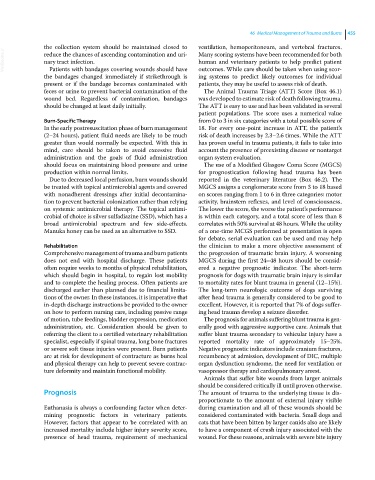Page 487 - Clinical Small Animal Internal Medicine
P. 487
46 Medical Management of Trauma and Burns 455
the collection system should be maintained closed to ventilation, hemoperitoneum, and vertebral fractures.
VetBooks.ir reduce the chances of ascending contamination and uri- Many scoring systems have been recommended for both
human and veterinary patients to help predict patient
nary tract infection.
Patients with bandages covering wounds should have
ing systems to predict likely outcomes for individual
the bandages changed immediately if strikethrough is outcomes. While care should be taken when using scor-
present or if the bandage becomes contaminated with patients, they may be useful to assess risk of death.
feces or urine to prevent bacterial contamination of the The Animal Trauma Triage (ATT) Score (Box 46.1)
wound bed. Regardless of contamination, bandages was developed to estimate risk of death following trauma.
should be changed at least daily initially. The ATT is easy to use and has been validated in several
patient populations. The score uses a numerical value
Burn‐Specific Therapy from 0 to 3 in six categories with a total possible score of
In the early postresuscitation phase of burn management 18. For every one‐point increase in ATT, the patient’s
(2–24 hours), patient fluid needs are likely to be much risk of death increases by 2.3–2.6 times. While the ATT
greater than would normally be expected. With this in has proven useful in trauma patients, it fails to take into
mind, care should be taken to avoid excessive fluid account the presence of preexisting disease or nontarget
administration and the goals of fluid administration organ system evaluation.
should focus on maintaining blood pressure and urine The use of a Modified Glasgow Coma Score (MGCS)
production within normal limits. for prognostication following head trauma has been
Due to decreased local perfusion, burn wounds should reported in the veterinary literature (Box 46.2). The
be treated with topical antimicrobial agents and covered MGCS assigns a conglomerate score from 3 to 18 based
with nonadherent dressings after initial decontamina- on scores ranging from 1 to 6 in three categories: motor
tion to prevent bacterial colonization rather than relying activity, brainstem reflexes, and level of consciousness.
on systemic antimicrobial therapy. The topical antimi- The lower the score, the worse the patient’s performance
crobial of choice is silver sulfadiazine (SSD), which has a is within each category, and a total score of less than 8
broad antimicrobial spectrum and few side‐effects. correlates with 50% survival at 48 hours. While the utility
Manuka honey can be used as an alternative to SSD. of a one‐time MCGS performed at presentation is open
for debate, serial evaluation can be used and may help
Rehabilitation the clinician to make a more objective assessment of
Comprehensive management of trauma and burn patients the progression of traumatic brain injury. A worsening
does not end with hospital discharge. These patients MGCS during the first 24–48 hours should be consid-
often require weeks to months of physical rehabilitation, ered a negative prognostic indicator. The short‐term
which should begin in hospital, to regain lost mobility prognosis for dogs with traumatic brain injury is similar
and to complete the healing process. Often patients are to mortality rates for blunt trauma in general (12–15%).
discharged earlier than planned due to financial limita- The long‐term neurologic outcome of dogs surviving
tions of the owner. In these instances, it is imperative that after head trauma is generally considered to be good to
in‐depth discharge instructions be provided to the owner excellent. However, it is reported that 7% of dogs suffer-
on how to perform nursing care, including passive range ing head trauma develop a seizure disorder.
of motion, tube feedings, bladder expression, medication The prognosis for animals suffering blunt trauma is gen-
administration, etc. Consideration should be given to erally good with aggressive supportive care. Animals that
referring the client to a certified veterinary rehabilitation suffer blunt trauma secondary to vehicular injury have a
specialist, especially if spinal trauma, long bone fractures reported mortality rate of approximately 15–25%.
or severe soft tissue injuries were present. Burn patients Negative prognostic indicators include cranium fractures,
are at risk for development of contracture as burns heal recumbency at admission, development of DIC, multiple
and physical therapy can help to prevent severe contrac- organ dysfunction syndrome, the need for ventilation or
ture deformity and maintain functional mobility. vasopressor therapy and cardiopulmonary arrest.
Animals that suffer bite wounds from larger animals
should be considered critically ill until proven otherwise.
Prognosis The amount of trauma to the underlying tissue is dis-
proportionate to the amount of external injury visible
Euthanasia is always a confounding factor when deter- during examination and all of these wounds should be
mining prognostic factors in veterinary patients. considered contaminated with bacteria. Small dogs and
However, factors that appear to be correlated with an cats that have been bitten by larger canids also are likely
increased mortality include higher injury severity score, to have a component of crush injury associated with the
presence of head trauma, requirement of mechanical wound. For these reasons, animals with severe bite injury

